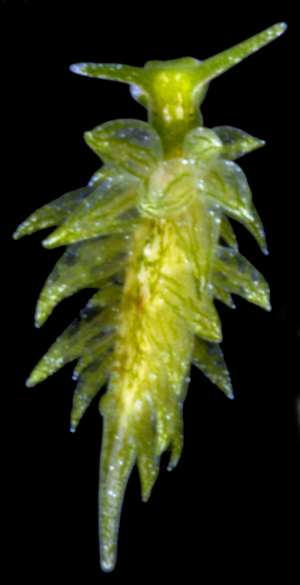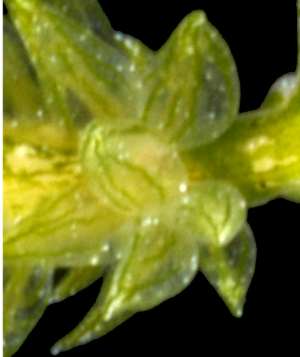
Ercolania subviridis
(Baba, 1959)
Order: SACOGLOSSA
Superfamily: LIMAPONTIOIDEA
Family: Limapontiidae
DISTRIBUTION
Known only from Japan
PHOTO
west coast of Okinawajima, Okinawa, Japan, East China Sea. Depth: 1 m. Length: several mm (data in Japan). 10-15 March 2005. low intertidal to shallow subtidal rocky shores. Photographer: Tomohiro Watanabe
Small aeolidiform sacoglossan, less than 10 mm long. Rhinophores, long and simple, with only a trace of a longitudinal groove at the base. The foot corners are rounded and the cerata are long and fusiform, narrowing to a rounded tip. The body is translucent yellowish with the finely branched green digestive gland showing through the body wall. There is a central core in each ceras consisting of green branches of the digestive gland and whitish albumen gland. Thin green longitudinal ducts of the digestive gland run up the inner side of the ceratal wall, giving each ceras a characteristic green-lined appearance.
Baba also described a red marking at the anterior end of pericardial prominence. In the accompanying photo on the Foruma reddish patch is present about halfway down the body. Baba mentioned Ercolania subviridis on a "green alga"... Trowbrideg recently reports it on Boodlea sp. in Okinawa [#13387 ].
- Baba, K. (1959) The family Stiligeridae from Japan (Opisthobranchia - Sacoglossa). Publications of the Seto Marine Biological Laboratory, 7: 327-334
Rudman, W.B., 2005 (March 22) Ercolania subviridis (Baba, 1959). [In] Sea Slug Forum. Australian Museum, Sydney. Available from http://www.seaslugforum.net/find/ercosubv
Related messages
Re: Ercolania subviridis ? from Okinawa
April 15, 2005
From: Kathe R. Jensen
Dear Bill & Cynthia,
Concerning message #13387: I agree that this is most likely the species described by Baba as Stiliger subviridis. The external morphology seems to be identical. I also agree with you that the sabot-shaped teeth described by Baba places this species in the genus Ercolania. It is good to know that it feeds on Boodlea. Have you by any chance seen egg masses? It would be really good to see what type of development it has.
Best wishes,
Kathe
krjensen@zmuc.ku.dk
Jensen, K.R., 2005 (Apr 15) Re: Ercolania subviridis ? from Okinawa. [Message in] Sea Slug Forum. Australian Museum, Sydney. Available from http://www.seaslugforum.net/find/13433Thanks Kathe,
Bill Rudman
Ercolania subviridis ? from Okinawa
March 22, 2005
From: Cynthia Trowbridge

Dear Bill and Kathe,
I am writing about another of the Ercolania a species that the Hiranos, their students, and I found in Okinawa in the last week or so. We think this species most closely fits the description of Ercolania subviridis (Baba 1959) for the following reasons:
-
Body yellowish white
-
Deep/dark green diverticula
-
Cerata have dark green veins internally
-
Deep green longitudinal lines on outer surface of cerata (see close-up)
-
Rhinophores long, slender, and simple
-
Foot-corners rounded
The longitudinal diverticula are the key identifying feature, even in Baba's black and white drawing. I removed one ceras and did a "squash" slide mount (both lit from above and below) to illustrate the diverticula.
Baba also described a red marking at the anterior end of pericardial prominence. We saw one at the posterior end (very faint) but do not recall about an anterior marking. I will mention a similar red patch (or patches) in another co-existing Ercolania species (see separate message).
Locality: west coast of Okinawajima, Okinawa, Japan, East China Sea. Depth: 1 m. Length: several mm (data in Japan). 10-15 March 2005. low intertidal to shallow subtidal rocky shores. Photographer: Tomohiro Watanabe
I am presenting this species with a cordial request for informal identification. My primary objective is to illustrate to colleagues what Ercolania subviridis may be (hopefully). Various web sites and books illustrate a wide range of species under this name (sort of like the "Placida dendritica " issue). It would be great if we could standardize what is recognized by this name.
Baba mentioned Ercolania subviridis on a "green alga"... our specimens were from Boodlea sp. in Okinawa. In many areas of Japan, Boodlea occurs in high-shore pools. However, in Okinawa, the alga is low on the shore or in the shallow subtidal. We have confirmed our species feeds on this alga.
If colleagues from Japan have verified or unverified records of this species, I would grateful for details. Thanks!
- Baba, K. (1959) The family Stiligeridae from Japan (Opisthobranchia - Sacoglossa). Publications of the Seto Marine Biological Laboratory, 7: 327-334
All the best,
Cynthia
trowbric@onid.orst.edu


Dear Cynthia,
Thanks for another interesting species. It certainly seems to fit Baba's description. The reddish mark you mention can be see in Tomohiro Watanabe's excellent photo of the whole animal, ain the midline about halfway down the body. I've also included a close-up of the anterior cerata. As well as showing the green 'lines' they also show a central core which I think in part is a branch of the albumen gland. The sabot-shaped radula teeth in Baba's description woudl suggest Ercolania is the correct genus for this species. - but we should wait for Kathe's comments.
I can only agree with your excellent aim to make it easier to identify these fascinating animals.
Best wishes,
Bill Rudman
